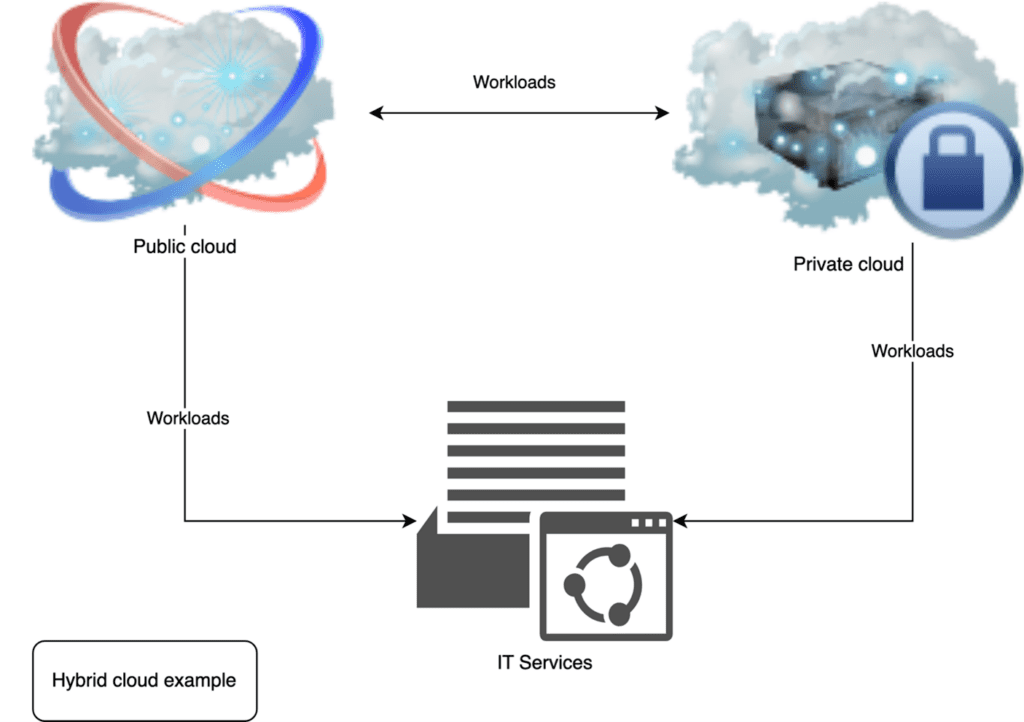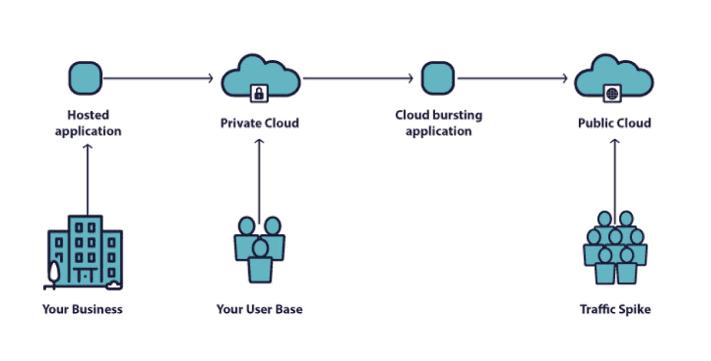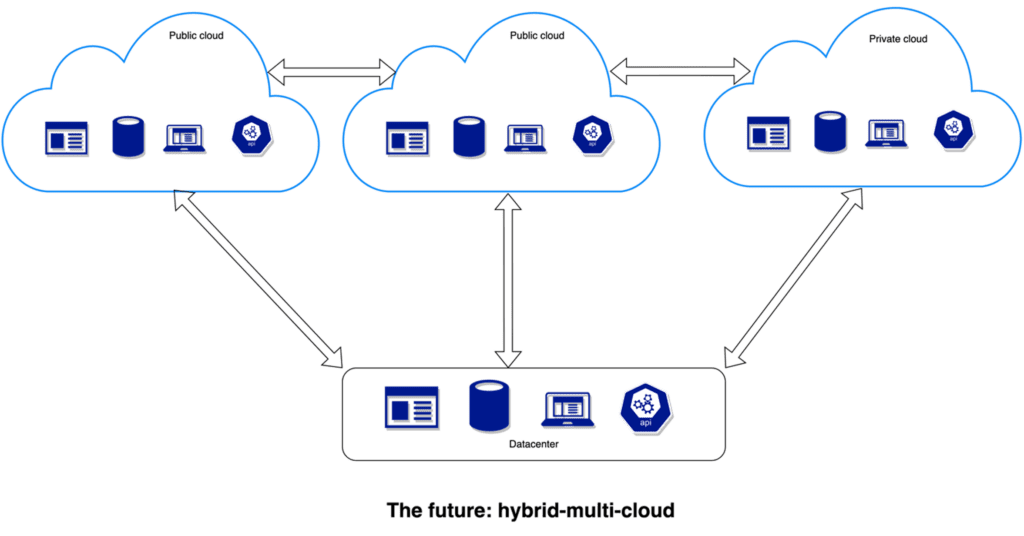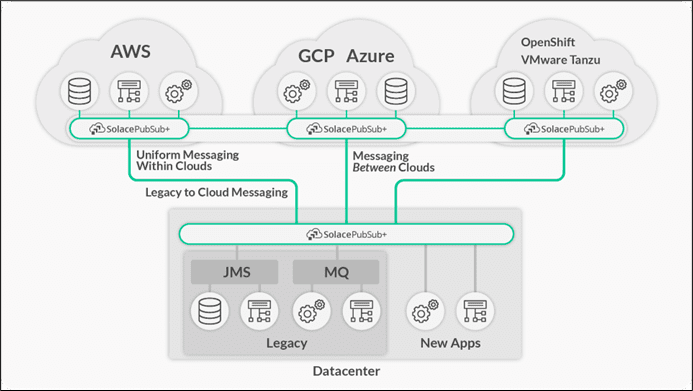Introduction to Cloud
Cloud computing stands as an indispensable pillar in today’s IT infrastructure. It offers a dynamic, resilient, and cost-efficient framework for data storage, application execution, and service delivery. The transformative potential of cloud computing empowers organizations to:
- Drive Cost Efficiency: by migrating to the cloud, organizations can streamline IT expenditures and optimize resource allocation.
- Enhance Agility and Flexibility: cloud technologies enable rapid adaptation to changing market demands, fostering business agility and flexibility.
- Amplify Scalability and Reliability: scalable cloud resources accommodate fluctuating workloads seamlessly, ensuring uninterrupted operations and reliability.
- Elevate Security and Compliance: cloud providers invest significantly in robust security measures, aiding organizations in fortifying data protection and meeting regulatory compliance.
- Accelerate Innovation: cloud ecosystems catalyze innovation by offering cutting-edge tools and technologies that expedite development and experimentation.
As the global landscape continues its digital transformation, the role of cloud computing is destined to become even more pivotal. It is an omnipotent instrument empowering organizations to optimize their IT infrastructure. Embracing cloud computing equips organizations with the means to diminish costs, heighten agility, and amplify scalability, thus steering them towards a brighter digital future.
Cloud Migration Strategies
In the ever-evolving landscape of IT, cloud computing has emerged as a transformative force. To harness its potential effectively, organizations often formulate distinct strategies tailored to their unique needs. Multi-cloud and hybrid cloud strategies have risen to prominence as powerful approaches in this endeavor. These strategies empower businesses to optimize their IT infrastructure, striking a balance between scalability, flexibility, control, and cost-efficiency. In this exploration, we delve into the intricacies of multi-cloud and hybrid cloud strategies, unveiling their advantages and applications in today’s digital era.
Hybrid-Cloud
Hybrid cloud seamlessly melds the capabilities of public cloud platforms like AWS with an organization’s private, on-premises infrastructure, creating a cohesive ecosystem designed to execute specific tasks with precision. This synergy allows workloads to be finely optimized, ensuring they operate in the most fitting environment at the precise moment needed.
The inherent flexibility of hybrid cloud is a significant boon. Organizations gain access to highly elastic computational resources provided by their chosen cloud provider, ideal for managing both peak workloads and everyday applications. However, it’s crucial to note that mission-critical operations remain securely anchored within the on-premises infrastructure. This strategic choice is driven by considerations like privacy regulations and the paramount importance of data security.
Advantages of a Hybrid-Cloud Strategy
- Cloud bursting: hybrid cloud introduces the concept of ‘cloud bursting,’ an application deployment technique. Here, an application primarily operates within a private cloud or data center but seamlessly ‘bursts’ into a public cloud when there is a surge in computing demand. This strategy grants organizations on-demand access to additional computing resources, precisely when they are required.
- High Availability and Disaster Recovery: enterprises harness the power of hybrid clouds to fortify their High Availability (HA) and Disaster Recovery (DR) capabilities. In this setup, the recovery environment resides in the public cloud, while the production environment remains secure in a private cloud. It stands ready to swiftly activate when needed. Data is replicated to the public cloud for redundancy, ensuring data integrity. During normal operation, non-essential resources remain in a non-operational state until they are required.
Multi-Cloud
A multi-cloud strategy entails the utilization of multiple cloud deployments, whether public or private, from diverse cloud providers. This approach allows businesses to curate a bespoke ecosystem, cherry-picking the finest applications and services from a spectrum of cloud offerings.
It is important to note that multi-cloud and hybrid cloud strategies need not be mutually exclusive; they can coexist harmoniously. In fact, many organizations opt for both to bolster security and performance, creating an expansive portfolio of cloud environments.
Advantages of a Multi-Cloud Strategy
- Enhanced Flexibility and Control: embracing a multi-cloud approach endows IT teams with heightened control over workloads and data. This dynamic cloud environment enables precise alignment with workload and application requirements, both from technical and economic perspectives.
- Geographic Advantage: multi-cloud strategies offer a strategic edge, especially in addressing concerns related to application latency. By leveraging multiple cloud providers, organizations can strategically position resources in proximity to their target audience, enhancing user experience. Additionally, some companies strategically engage specific cloud providers for short-term objectives, enabling agile adjustments in cloud usage.
- Mitigating Vendor Lock-in and Outage Risks: Concerns about vendor lock-in and the potential for cloud provider outages are prominent considerations for IT leaders advocating for a multi-cloud strategy. This approach mitigates the risk of being overly dependent on a single provider, ensuring business continuity even in the face of unexpected disruptions.
A Hybrid-Multi-Cloud strategy
A hybrid-multi-cloud strategy combines on-premises infrastructure with private and public cloud services, offering organizations the best of three worlds: the cloud’s flexibility and scalability, on-premises security and control, and the freedom to select the ideal cloud provider for each workload.
Benefits of a Hybrid-Multi-Cloud Strategy
- Flexibility and Agility: easily adapt to changing business needs by selecting the most suitable cloud environment for each workload, considering factors like cost, performance, and features.
- Cost Savings: negotiate competitive pricing with cloud providers by leveraging multiple options, optimizing costs for each workload.
- Disaster Recovery and Security: enhance disaster recovery and security posture by distributing workloads across multiple cloud environments.
- Innovation: stay at the forefront of cloud innovations by utilizing multiple cloud providers.
Challenges of a Hybrid-Multi-Cloud Strategy
- Data Integration: ensuring seamless data flow and interoperability between on-premises systems, private clouds, and diverse public cloud providers can be complex.
- Security and Compliance: coordinating consistent security and compliance across diverse environments poses challenges.
- Network Complexity: networking complexities arise in connecting and securing hybrid and multi-cloud environments.
- Monitoring and Governance: effective monitoring and governance practices are essential for visibility and control.
- Application Compatibility: some applications may require adaptation to run seamlessly across different cloud environments.
- Data Residency and Privacy: compliance with data laws becomes complex when data spans multiple regions and clouds.
Solace Platform: The EDA Solution to your Hybrid-Multi-Cloud Problems!
Solace Platform stands as a robust, scalable, and secure messaging platform, facilitating real-time data streaming and event-driven communication within hybrid and multi-cloud environments. It serves as a unified infrastructure layer, enabling seamless event publication and subscription, irrespective of an application’s location.
This platform is a potent instrument for addressing the complexities inherent in hybrid-multi cloud strategies. It offers a unified infrastructure layer that fosters seamless communication and data exchange among applications, whether they are deployed on-premises, in private clouds, or within public clouds.
Solace Platform is made up of three key components:
- Solace Event Broker: at the core of the platform, these brokers are responsible for efficiently routing and delivering events between applications.
- Cloud SaaS Offering: the Solace Cloud SaaS offering is a fully managed EDA platform hosted in the cloud. It simplifies the adoption of the Solace brokers and event mesh, eliminating the need for infrastructure management.
- Mesh Manager: this tool streamlines the deployment and management of hybrid and multi-cloud event meshes. It facilitates seamless connections among Solace brokers across various environments, including on-premises, with just a few clicks.
Solace Platform offers multifaceted solutions to tackle the challenges associated with hybrid-multi-cloud strategies:
- Data Integration: the event mesh establishes a unified data bus, enabling real-time event publication and subscription, irrespective of an application’s location. This simplifies data integration across diverse sources, including on-premises systems, private clouds, and public clouds.
- Security and Compliance: Solace Platform boasts a robust set of security features, encompassing encryption, authentication, and authorization. These safeguards ensure data protection during transit between various environments, aiding organizations in adhering to data privacy and security regulations.
- Network Simplification: by providing a pivotal point of connection for all applications, Solace Platform streamlines network complexity. This simplification enhances the manageability and security of network traffic within on-premises, private cloud, and public cloud environments.
- Monitoring and Governance: Solace delivers a consolidated view of event traffic, facilitating seamless monitoring and management across diverse environments. Moreover, it offers governance features, including role-based access control and auditing.
- Application Compatibility: supporting an array of messaging protocols, such as AMQP, JMS, and REST, Solace Platform ensures seamless integration of existing applications, regardless of programming language or platform.
- Streamlined Change Management: Solace Platform reduces the need for extensive change management by providing a unified infrastructure layer. This empowers the development and deployment of applications without the complexities of underlying messaging infrastructure.
- Data Residency and Privacy: with the ability to route data to specific geographic regions, Solace assists organizations in complying with data privacy and security regulations, ensuring data residency and privacy requirements are met.
Conclusion
Cloud computing is the linchpin of modern IT infrastructure, offering cost-efficiency, agility, scalability, security, and innovation. As the digital landscape evolves, cloud computing’s importance grows. Multi-cloud and hybrid cloud strategies have emerged as powerful tools. Hybrid cloud seamlessly blends public and private cloud capabilities for optimal workload performance. Multi-cloud strategies offer flexibility, control, and geographic advantages, mitigating vendor lock-in and outages.
For those seeking a balanced approach, the hybrid-multi-cloud strategy combines on-premises infrastructure with public and private cloud services, delivering flexibility, cost savings, enhanced disaster recovery, and access to cloud innovations. Challenges like data integration, security, network complexity, monitoring, governance, application compatibility, change management, and data privacy accompany these strategies. Solace Platform simplifies these complexities, making real-time data communication seamless.
In conclusion, cloud computing, coupled with strategic deployment, optimizes IT infrastructure. Solace Platform paves the way for a more agile, efficient, and secure digital future.
Explore other posts from category: For Architects

 Hari Rangajaran
Hari Rangajaran





